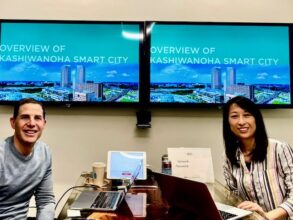
Venture West Preview
When it comes to built world innovation, Silicon Valley is not just a place for digital transformation of how we design, build and maintain our physical infrastructure, it is also a hotbed for identifying the technology that will change both the design of our buildings and infrastructure, and how those structures function. At a certain level, as we look at digital transformation in the built environment, it becomes difficult to separate digital transformation of process from product – a principle that our reporting in the Bay Area, in advance of our San Francisco conference, repeatedly underscores. Beyond that, as we saw on a recent visit with Mitsui Fudosan’s Urban Planning and Development Department Silicon Valley Representative Kaori Nishibayashi, it also becomes difficult to think about truly optimizing component structures versus optimization of the entire system of structures taken as a whole.
Taking a global approach to achieving the digital potential of the built environment to do more for its inhabitants is rare air. Only a handful of massive, private real estate companies and governments are capable of operating at the scale necessary to think truly holistically about how best to leverage technology to the advantage of a region’s inhabits. Mitsui Fudosan’s Kashiwanoha Smart City stands as one of a very few case studies of major attempts at digital enablement at city-scale.
First the Team and the Mission. Then, the Technological Solutions, Next.
There are several remarkable features of Kashiwanoha, and probably the first striking point is that the city is an actual real estate project, and the approach to the project began with goals that then helped frame the priorities for technology adoption within the project. The goals were laid out in three themes, as follows:
New industry creation—Fostering growth industries that will instill Japan with new vitality.
Health and longevity- Providing secure and healthy living for people of all generations
Environmental harmony—Friendly to the Earth in every respect.
Also, unlike many smart city projects, Kashiwanoha was already home to a significant population. So the team involved residents from the area from the beginning, and, although Mitsui Fudosan is a private company, it created a partnership with both public, academic and other partners to help govern the development and redevelopment of the area. In approaching the further development of Kashiwanoha, Mitsui Fudosan formed a joint administrative partnership with groups including the University of Tokyo, Chiba University, Chiba Prefecture, Kashiwa City, Kashiwa Chamber of Commerce and Industry, Tanaka Community Furusato Council, and the Metropolitan Intercity Railway.
It is very important to consider this participatory approach to the further development of the area because it stands in contrast to so many efforts to create so-called smart cities that have been criticized for their “top down” approach. It is clear, in this instance, that Mitsui Fudosan is a case study that stands in contrast.
Three “Solutions” Matched to the Three Thematic Objectives for Kashiwanoha
Having identified three major themes for Kashiwanoha, the team at Mitsui Fudosan has been able to identify and foster new technology-enabled solutions that appropriately help address the project’s thematic priorities. In the realm of creating new industries, the group has established a new accelerator space, KOIL, complete with co-working space and also fully outfitted digital manufacturing facilities and resources. In the area of health and longevity, they have similarly created a sort of “participatory” health and wellness environment where people can be part of an opportunity to participate with the University of Tokyo and and an ecosystem of health-related tech companies to explore ways to monitor and support healthy living across a range of building types – all on an “opt-in” basis. Then, in the energy arena, the group has created a smart grid with an Area Energy Management System that helps promote both the vision of the community as a zero-carbon environment and also the idea of sustainability, as power can be managed from various sources to combat any possible interruption to power.
In each case, the concept of a very open, participatory, and transparent environment where people make the right decisions because they buy into the vision is central to the thesis.
Tokyo Dome City: A New Real Estate Opportunity To Identify and Leverage New Technologies To Address Different Needs
While Kashiwanoha marks a very ambitious undertaking for a privately held company, Mitsui Fudosan seems intent on continuing to learn about emerging technology to identify solution partners and to apply those solutions to its real estate projects to help drive greater success for them. A newer example of Mitsui Fudosan’s efforts can be seen in their approach to development and redevelopment at Japan’s famed Tokyo Dome, famed home to the Tokyo Giants baseball team, a property Mistui Fudosan acquired for $1.2 billion in 2020. Today, Mitsui Fudosan is in the midst of a massive redevelopment of Tokyo Dome City with ambitions to create a truly global entertainment district there, fueled by a bold digital strategy.
This vision brings us back to our visit with Nishibayashi. As part of the firm’s efforts, Nishibayashi is investing herself in the Silicon Valley ecosystem learning about the latest technology in development and bringing insights back to the team at Mitsui Fudosan, possibly to be deployed in one of Japan’s most beloved areas to better extend its reach to and connection with the world at large.

Discussion
Be the first to leave a comment.
You must be a member of the BuiltWorlds community to join the discussion.